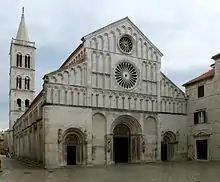Catholic Church in Croatia
The Catholic Church in Croatia (Croatian: Katolička crkva u Hrvatskoj) is part of the worldwide Catholic Church that is under the spiritual leadership of the Pope, Roman Curia and the Croatian Bishops' Conference. Its administration is centered in Zagreb, and it comprises five archdioceses, 13 dioceses and one military ordinariate. Cardinal Josip Bozanić is the Roman Catholic Archbishop of Zagreb.
Catholic Church in Croatia | |
|---|---|
| Croatian: Katolička crkva u Hrvatskoj | |
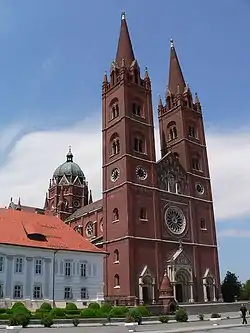 | |
| Type | National polity |
| Orientation | Catholic Church |
| Governance | Episcopal |
| Pope | Pope Francis |
| Apostolic Nuncio | Giuseppe Pinto |
| Region | Croatia |
| Language | Croatian, Latin |
| Founder | Pope John IV and Abbot Martin, according to tradition |
| Origin | c. 65: in Roman Illyricum c. 640: Croatian Christianity |
| Members | 3,697,143 (2011) |
| Ministers | c. 3800[1] |
| Official website | Croatian Bishops' Conference |
| Part of a series on the |
| Catholic Church in Croatia |
|---|
 |
|
There are an estimated 3.7 million baptized Latin Catholics and about 20,000 baptized Greek Catholics in Croatia, comprising 86.3% of the population, according to the 2011 census. Weekly Church attendance is relatively high compared to other Catholic nations in Europe, being around 27%.[2] The national sanctuary of Croatia is in Marija Bistrica, while the country's patron is Saint Joseph since the Croatian Parliament declared him to be in 1687.[3]
History
Roman Illyrians and early Christianity
The western part of the Balkan Peninsula was conquered by the Roman Empire by 168 BC after a long drawn out process known as the Illyrian Wars.
Following their conquests, the Romans organised the area into the province of Illyricum, which was eventually split up into Dalmatia and Pannonia. Through being part of the Roman Empire, various religious cults were brought into the region. This included the Levantine-originated religion of Christianity.
Indeed, Salona, a Greek-founded city close to modern Split, was one of the earliest places in the region connected with Christianity. It was able to gain influence first among some of the Dalmatian Jews living in the city. St. Titus, a disciple of St. Paul the Apostle and the subject of the Epistle to Titus in the New Testament, was active in Dalmatia. Indeed, in the Epistle to the Romans, Paul himself speaks of visiting "Illyricum", but he may have meant Illyria Graeca.
Conversion of the Croats
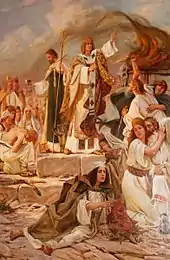
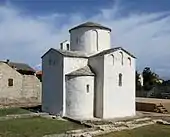
The Croats arrived in the area of present-day Croatia during the early part of the 7th century AD. They came in touch with the Christian natives and started to slowly accept Christianity. Byzantine and Frankish missionaries and Benedictines who were bringing Western cultural influences had a significant role in the christening of Croats.
Croats had their first contact with the Holy See in year 641 when the papal envoy Abbot Martin came to them in order to redeem Christian captives and the bones of the martyrs that Croats were keeping. There is little information about the "Baptism of the Croats", but it is known that it was peacefully and freely accepted, and that it took place between the 7th and the 9th century.
Byzantine emperor Constantine Porphyrogenitus wrote in his book De Administrando Imperio that the Byzantine Emperor Heraclius, during whose reign Croats came to the land between Drava river and the Adriatic Sea (present-day Croatia), "brought priests from Rome who he made into archbishop, bishop, priests and deacons, which then baptized Croats."
Historical sources mention the christening of Croatian rulers Porga, Vojnomir, Višeslava, Borna, Ljudevit Posavski and others.
By the 9th century, Croats have already been fully included in a large European Christian community. Croatian rulers Mislav (around 839), Trpimir I (852) and many others were building churches and monasteries. In 879, Croatian duke Branimir wrote a letter to Pope John VIII in which he promised him loyalty and obedience. Pope John VIII replied with a letter on 7 June 879, in which he wrote that he celebrated a Mass at the tomb of St Peter on which he invoked God's blessing on Branimir and his people.
In 925, Croatian King Tomislav was corresponding with Pope John X on the occasion of the first Church Council of Split. The pope's letter to the King Tomislav is the first international document in which a Croatian ruler was called rex (King); that is why Tomislav is considered to be the first Croatian king.
King Demetrius Zvonimir was crowned on 8 October 1076[4] at Solin in the Basilica of Saint Peter and Moses (known today as the Hollow Church) by Gebizon, a representative of Pope Gregory VII.[5][6]
Zvonimir took an oath of allegiance to Pope, by which he promised his support in the implementations of the Church reforms in Croatia. After the Papal legate crowned him, Zvonimir in 1076 gave the Benedictine monastery of Saint Gregory in Vrana to the Pope as a sign of loyalty and as an accommodation for papal legates coming to Croatia.[7]
Middle Ages
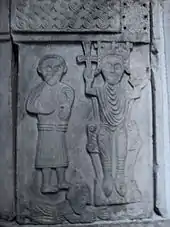
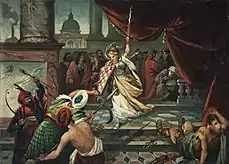
When Croatia lost its own dynasty and entered into a personal union with Hungary in 1102, the Benedictines were slowly dying out, while the mendicant orders, especially Franciscans and Dominicans were becoming more important. Religious and cultural formation of Croats was also strongly influenced by Jesuits. Church writers from northern Croatia and Dubrovnik, which was a free center of the Croatian culture, have done a lot for standardization and expansion of the Croatian literary language.
Ban on marriage to minor degrees of relationship imposed by the Roman Catholic Church was met with heavy criticism in the Croatian society of the time, which led to a schism in the Croatian church.[8] A Croatian delegation led by a bearded priest named Vuk met with Pope Honorius II in the early 12th century, in order to discuss the issues of the time, like the use of Slavonic liturgy in Croatia which was seen as a major problem by the Pope and the synod.[9] Since the 9th century there is in Croatia a unique phenomenon in the entire world of Catholicism, liturgy that was held in Church Slavonic language with special Glagolitic script (Pope was allowing serving liturgy only in Latin). Despite the various disputes, Pope Innocent IV approved use of Church Slavonic language and the Glagolitic script to Filip, bishop of Senj, thus making Croats the only Latin Catholics in the world allowed to use a language other than Latin in their liturgy prior to the Second Vatican Council in 1962.[10]
During the Croatian–Ottoman Wars that lasted from 15th to 19th century Croats strongly fought against the Turks which resulted in the fact that the westernmost border of the Ottoman Empire and Europe became entrenched on the soil of the Croatian Kingdom. In 1519, Croatia was called the Antemurale Christianitatis by Pope Leo X.
Austrian Empire/Austria-Hungary
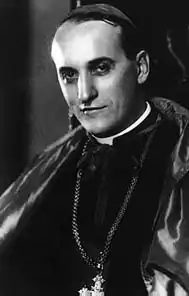
The Austrian Empire signed a concordat with the Holy See in 1855 which regulated the Catholic Church within the empire.[11]
Kingdom of Yugoslavia
In Yugoslavia, the Croatian bishops were part of the Bishops' Conference of Yugoslavia.
The Church in the Independent State of Croatia
In 1941, a Nazi puppet state, so-called Independent State of Croatia (NDH), was established by the fascist dictator Ante Pavelić and his Ustaše movement. The Ustaša regime pursued a genocidal policy against the Serbs (who were Eastern Orthodox Christians), Jews and Romani.
Historian Michael Phayer wrote that the creation of the NDH was initially welcomed by the hierarchy of the Catholic Church and by many Catholic priests. Ante Pavelić was anti-Serb and pro-Catholic, viewing Catholicism as an integral part of Croat culture.[12]
British writer Peter Hebblethwaite wrote that Pavelić was anxious to get diplomatic relations and a Vatican blessing for the new 'Catholic state' but that "neither was forthcoming".
The Archbishop of Zagreb, Aloysius Stepinac, wanted Croatia's independence from the Serb dominated Yugoslav state which he considered to be "the jail of the Croatian nation", so he arranged the audience with Pius XII for Pavelić.[12]
Vatican under Secretary of State Giovanni Montini (later Pope Paul VI)'s minutes before the meeting noted that no recognition of the new state could come before a peace treaty and that "The Holy See must be impartial; it must think of all; there are Catholics on all sides to whom the [Holy See] must be respectful."[13]
The Vatican refused formal recognition of NDH but Pius XII sent a Benedictine abbot Giuseppe Ramiro Marcone as his apostolic visitor. Pius was criticized for his reception of Pavelić but he still hoped that Pavelić would defeat communist Partisans and reconvert many of the 200,000 who had left the Catholic Church for the Serbian Orthodox Church since World War I.[12]
Many Croatian nationalist clergy supported the Pavelić's regime push to drive out Serbs, Gypsies and Jews, or force their conversion to Catholicism.[14] Despite that, Pavelić told Nazi Foreign Minister von Ribbentrop that while the lower clergy supported the Ustaše, the bishops, and particularly Archbishop Stepinac, were opposed to the movement because of "Vatican international policy".[13]
Phayer wrote that Stepinac came to be known as "judenfreundlich" ("Jew friendly") to the Nazi-linked Ustaše regime, and suspended a number of priest collaborators in his diocese.[15]
Archbishop Stepinac made many public statements criticizing developments in the NDH. On Sunday, 24 May 1942, to the irritation of Ustaša officials, he used the pulpit and a diocesan letter to condemn genocide in specific terms, although not mentioning Serbs:
All men and all races are children of God; all without distinction. Those who are Gypsies, Black, European, or Aryan all have the same rights.... for this reason, the Catholic Church had always condemned, and continues to condemn, all injustice and all violence committed in the name of theories of class, race, or nationality. It is not permissible to persecute Gypsies or Jews because they are thought to be an inferior race.[16]
He also wrote a letter directly to Pavelić on 24 February 1943, stating:
The very Jasenovac camp is a stain on the honor of the NDH. Poglavnik! To those who look at me as a priest and a bishop I say as Christ did on the cross: Father forgive them for they know not what they do.[17]
Thirty-one priests were arrested following Stepinac's July and October 1943 explicit condemnations of race murders being read from pulpits across Croatia.[18] Martin Gilbert wrote that Stepinac, "who in 1941 had welcomed Croat independence, subsequently condemned Croat atrocities against both Serbs and Jews, and himself saved a group of Jews".[19]
The Yugoslav Partisans executed two priests, Petar Perica and Marijan Blažić, as collaborationists on the island of Daksa on 25 October 1944. The Partisans killed Fra Maksimilijan Jurčić near Vrgorac in late January 1945.[20]
The Church in communist Yugoslavia
The National Anti-Fascist Council of the People's Liberation of Croatia (ZAVNOH) originally foresaw a greater degree of religious freedom in the country. In 1944 ZAVNOH still left open the possibility of religious education in schools.[21]
This idea was scuttled after Yugoslav leader Josip Broz removed secretary of the Central Committee of the Communist Party of Croatia Andrija Hebrang and replaced him with hardliner Vladimir Bakarić.[22]
In 1945, the retired bishop of Dubrovnik, Josip Marija Carević, was murdered by Yugoslav authorities.[23] Bishop Josip Srebrnić was sent to jail for two months.[24] After the war, the number of Catholic publications in Yugoslavia decreased from one hundred to only three.[25]
In 1946, the Communist regime introduced the Law on State Registry Books which allowed the confiscation of church registries and other documents.[26] On 31 January 1952, the communist regime officially banned all religious education in public schools.[27]
That year the regime also expelled the Catholic Faculty of Theology from the University of Zagreb, to which it was not restored until democratic changes in 1991.[28][29]
In 1984, the Catholic Church held a National Eucharistic Congress in Marija Bistrica.[30]
The central mass held on September 9 was attended by 400,000 people, including 1100 priests, 35 bishops and archbishops, as well as five cardinals. The mass was led by cardinal Franz König, a friend of Aloysius Stepinac from their early studies. In 1987 the Bishops' Conference of Yugoslavia issued a statement calling on the government to respect the right of parents to obtain a religious education for their children.[31]
The Church in the Republic of Croatia
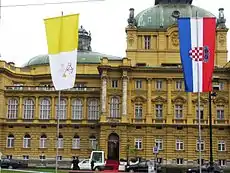
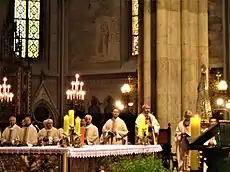
After Croatia declared its independence from Yugoslavia, the Catholic Church regained its full freedom and influence.
During the Croatian War of Independence Catholicism and Orthodoxy were often cited as a basic division between Croats and Serbs, which led to a massive destruction of churches (some 1,426 were destroyed or damaged).
In the Republic of Croatia, the Catholic Church has defined its legal position as autonomous in some areas, thus making it able to: provide religious education in state primary and secondary schools to those students who choose it, establish Catholic schools and conduct pastoral care among the Catholics in the armed forces and police.
Through the ratification of treaties between the Holy See and Croatia on 9 April 1997, treaties that regulate legal issues, cooperation in education and culture, conducting pastoral care among the Catholics in the armed forces and police and financing Church from the state budget came into force. As regards to financing, the Church has received the following amounts of money over the last decade: 2001; 461.3 bln kunas, 2004-2007; 532 bln kunas, 2008-2011;475.5 bln kunas, 2012-2013; 523.5 bln kunas, plus around 200 million kunas per each year for teachers of religious studies in schools, around 60 million kunas for maintenance churches which are considered to be a cultural heritage etc.[32]
Catholic Church in Croatia is very active in social and political life. The church has implemented a number of actions in conservative spirit in order to promote its values such as: non-working Sunday, punishment of the crimes of the communist era, introducing religious education in schools, protection of marriage as the union of a man and a woman (2013 referendum), opposition to abortion (campaign: "Protecting human life from conception to natural death"), opposition to euthanasia, opposition to natural methods of family planning and the treatment of infertility, and opposition to artificial birth control methods.
With Croatian independence, the Croatian Bishops' Conference was formed. The Croatian Bishops' Conference established Croatian Catholic Radio in 1997.[33]
Demographics
The published data from the 2011 Croatian census included a crosstab of ethnicity and religion which showed that a total of 3,697,143 Catholic believers (86.28% of the total population) was divided between the following ethnic groups:[34]
- 3,599,038 Catholic Croats
- 22,331 Catholic believers of regional affiliation
- 15,083 Catholic Italians
- 9,396 Catholic Hungarians
- 8,521 Catholic Czechs
- 8,299 Catholic Roma
- 8,081 Catholic Slovenes
- 7,109 Catholic Albanians
- 3,159 Catholic Slovaks
- 2,776 Catholic believers of undeclared nationality
- 2,391 Catholic Serbs
- 1,913 Catholic believers of other nationalities
- 1,847 Catholic Germans
- 1,692 Catholic Ruthenians
- 1,384 Catholic believers of unknown nationality
- 1,339 Catholic Ukrainians
- other individual ethnicities (under 1,000 people each)
Organisation
Hierarchy
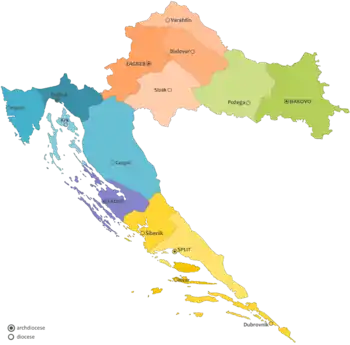
Within Croatia the hierarchy consists of:
The bishops are organized into the Croatian Conference of Bishops, which is presided by the Archbishop of Zadar Mons. Želimir Puljić.
There are also historical bishoprics, including:
As of 2009, there were 1570 Catholic parishes in Croatia.[35]
Franciscans
There are three Franciscan provinces in the country:
- the Franciscan Province of Saints Cyril and Methodius based in Zagreb,
- the Franciscan Province of Saint Jerome based in Zadar and
- the Franciscan Province of the Most Holy Redeemer based in Split.
Attitudes
Although the vast majority of Croatians declare themselves as Catholics, many of them do not follow the Church's teaching on moral and social issues. According to a Pew Research poll from 2017, only 27% of respondents attend mass regularly, 25% support the Church's stance on contraception, 43% support the Church's stance on ordination of women and 38% think abortion should be illegal in most cases. On the other hand, 66% support the Church's stance on same-sex marriage.[36]
Controversies
The Catholic Church in Croatia is criticised by some for promoting and tolerating neo-fascism[37] among its ranks:
Each year in December, the Catholic church in Croatia holds the annual memorial mass[38] dedicated to Ustasha fascist dictator Ante Pavelić in Zagreb and Split. These masses are known to attract groups of Pavelić's supporters dressed in clothes with Ustasha insignia.[39][40]
During the funeral of convicted ustasha WWII concentration camp commander Dinko Šakić, priest Vjekoslav Lasić said that "every honest Croat should be proud of Šakić's name"[41][42] and that "court which convicted Šakić, also convicted Croatia and its people".[43] These statements were strongly condemned by Simon Wiesenthal Center and Croatian Helsinki Committee.[41]
Croatian president Kolinda Grabar-Kitarović was criticised on live TV by Croatian friar Luka Prcela for saying that the Independent State of Croatia was a criminal state and wasn't independent. Prcela said that the Independent State of Croatia "never killed anyone outside its own borders" and that former two left-wing presidents of Croatia were "anti-Croatian".[44]
Bishop of Sisak Vlado Košić was one of the signatories of a petition for the introduction of the fascist Ustasha movement salute Za dom spremni to the official use in the Croatian Armed Forces.[45]
On 1 July 2017, Don Anđelko Kaćunko held a memorial mass for Ustasha Black Legion commander Jure Francetić on which he described Francetić as "a patriot who was willing to give his life for the homeland".[46]
On 2 July 2017, media published a picture of a Croatian Catholic priest posing for a picture with a group of young boys on a children’s football tournament in Široki Brijeg, Bosnia and Herzegovina. Their team was named "The Black Legion" and boys were all wearing black T-shirts, thus alluding to notorious ustasha militia of the same name.[47]
On 2 September 2017, while holding a mass near the town of Sinj, friar Božo Norac Kljajo equalized Za dom spremni and Praised be Jesus by saying that these are "both good intentioned, human and ancient Christian salutes which don't hold a single drop of hate or vengeance."[48]
Upon the death of Slavko Goldstein, a prominent Croatian writer and publisher of Jewish origin, Mili Plenković, pastor of Hvar, published a Facebook post in which he expressed that he was "happy upon hearing the news that Goldstein died" because according to him: "yet another hater of Croatia vanished from this world".[49][50]
Places of Pilgrimage of the Croats
Notable people
- Josip Bozanić
- Juraj Dobrila, 19th-century bishop from Istria
- Ivan Grubišić, priest from Dalmatia, Member of Parliament 2011–2015
- Marija Krucifiksa Kozulić, established the only indigenous community of nuns founded in the Archdiocese of Rijeka
- Franjo Kuharić
- Antun Mahnić, initiator of the Croatian Catholic Movement
- Ivan Merz, blessed layman and Catholic activist
- Alojzije Stepinac, archbishop of Zagreb during World War II
- Josip Juraj Strossmayer
- Franjo Šeper
See also
References
- "Koliko ima pedofila u Crkvi?". Retrieved 18 April 2017.
- "Religious Belief and National Belonging in Central and Eastern Europe". Pew Research Center.
- http://www.sabor.hr/Default.aspx?art=28406 Archived 2016-02-13 at the Wayback Machine "At its season on June 9th and 10th 1687 Croatian Parliament encouraged by the Bishop of Zagreb Martin Borković, unanimously declared St Joseph to be the patron of the Croatian Kingdom".
- Dominik Mandić, Rasprave i prilozi iz stare hrvatske povijesti, Institute of Croatian history, Rome, 1963, pp. 315, 438.
- Demetrius, Duke of Croatia and Dalmatia Archived 2006-02-12 at the Wayback Machine He was granted the royal title by Gregory after pledging "Peter's Pence" to the Pope.
- Tomislav Raukar Hrvatsko srednjovjekovlje, Školska knjiga, Zagreb, 1997. ISBN 953-0-30703-9, str. 49
- Florin Curta: Southeastern Europe in the Middle Ages, 500-1250, p. 262
- Dvornik, Francis (1970). Byzantine mission among the Slavs. Rutgers University Press. p. 241. ISBN 0813506131.
- Dvornik, Francis (1970). Byzantine mission among the Slavs. Rutgers University Press. p. 241. ISBN 0813506131.
- http://www.benedictines-cib.org/meetings/2009Croatia/Jozo_Crkva_u_Hrvatskojna_hrv.pdf
- Ljiljana Dobrovšak. Ženidbeno (bračno) pravo u 19. stoljeću u Hrvatskoj
- Phayer, Michael. The Catholic Church and the Holocaust 1930-1965, Indiana University Press; 2000, pg. 32.
- Hebblethwaite, Peter. Paul VI, the First Modern Pope, Harper Collins Religious; 1993; pp. 153-57, 210-11
- Evans, Richard J., The Third Reich at War, Penguin Press; New York 2009, pp. 158-59.<-- ISSN/ISBN needed-->
- Phayer, p. 86.
- Apud: Dr H. Jansen, Pius XII: chronologie van een onophoudelijk protest, 2003, pg. 151.<--ISSN/ISNN needed, if any-->
- Alojzije Viktor Stepinac: 1896-1960 Archived 30 May 2003 at the Wayback Machine
- Phayer, p. 47.
- Gilbert, Martin. The Righteous - The Unsung Heroes of the Holocaust, Doubleday (2002), pp. 203, 466; ISBN 0385 60100X.
- "Partizan Jure Galić: Moji suborci pobili su 30 Vrgorčana". Retrieved 18 April 2017.
- Tanner (1997), p. 164
- Tanner (1997), pg. 165.
- "Religious Communities in Croatia from 1945 to 1991". Retrieved 18 April 2017.
- Akmadža, Miroslav. Katolička crkva u Hrvatskoj i komunistički režim 1945-1966, Rijeka: Otokar Keršovani, 2004 (pg. 69)<--ISSN/ISBN added-->
- Mitja Velikonja. Religious Separation and Political Intolerance in Bosnia-Herzegovina, Texas A&M University Press, 2003 (pg. 200) <-- ISSN/ISBN -->
- Miroslav Akmadža. Oduzimanje crkvenih matičnih knjiga u Hrvatskoj u vrijeme komunizma
- Akmadža, Miroslav. Katolička crkva u Hrvatskoj i komunistički režim 1945-1966, Biblioteka Svjedočansta. Rijeka, 2004 (p. 93)<--ISSN/ISBN needed-->
- Goldstein, Ivo. Croatia: A History . McGill Queen's University Press, 1999. (pg. 169)
- "Stranica nije pronađena. – Katolički bogoslovni fakultet". Archived from the original on 22 July 2008. Retrieved 18 April 2017.
- "How Gospa destroyed the SFRY". Globus. Archived from the original on 21 September 2008. Retrieved 18 April 2017.
- Sabrina P. Ramet. Catholicism and politics in communist societies. Duke University Press, 1990 (p. 194)<--ISSN/ISBN needed-->
- "Prvi Put Dostupni Podaci o Uplatama Od 2003. godine Kaptol je od države dobio 6 milijardi kuna". Retrieved 18 April 2017.
- "Hrvatski katolički radio u povodu 10. obljetnice emitiranja". Glas Koncila. Archived from the original on 28 October 2007. Retrieved 18 April 2017.
- "4. Population by ethnicity and religion". Census of Population, Households and Dwellings 2011. Croatian Bureau of Statistics. Retrieved 2012-12-17.
- "Kad tata služi misu – Nacional.hr". Retrieved 18 April 2017.
- http://assets.pewresearch.org/wp-content/uploads/sites/11/2017/05/09154356/Central-and-Eastern-Europe-Topline_FINAL-FOR-PUBLICATION.pdf
- "Croatian Church Urged to Tackle 'Fascist Sympathisers' :: Balkan Insight". www.balkaninsight.com. Retrieved 2017-07-02.
- "U Centru Zagreba Održana Misa Zadušnica Za Antu Pavelića Okupila se šačica obožavatelja ustaškog zločinca, pozirali u majicama s velikim slovom 'U'". jutarnji.hr. Retrieved 2017-07-01.
- "Memorial Mass for Croatian Nazi Slammed as 'Disgrace' :: Balkan Insight". www.balkaninsight.com. Retrieved 2017-07-01.
- "Zuroff protests against Mass for Ustasha leader Pavelic". tportal.hr. Retrieved 2017-07-01.
- "Pateru Vjekoslavu Lasiću prijeti zatvorska kazna". Slobodna Dalmacija (in Croatian). Retrieved 2017-07-01.
- "Zašto je hrvatska vlast odšutjela Šakićev sprovod?" (in Croatian). Retrieved 2017-07-01.
- "Pater Lasić: Šakiću je Bog sve oprostio". Slobodna Dalmacija (in Croatian). Retrieved 2017-07-01.
- "Sramota Uživo Na HTV-u: Svećenik s oltara: 'Ne mogu oprostiti predsjednici jer je rekla da je NDH bila zločinačka'". Net.hr (in Croatian). 2016-05-08. Retrieved 2017-07-01.
- "Bizarnu Peticiju Potpisao I Šimunić Od predsjednice traže uvođenje pozdrava 'Za dom spremni' u Oružane snage!". jutarnji.hr. Retrieved 2017-07-01.
- "Propalo Postavljanje Ploče U Spomen Ustaši Juri Francetiću Specijalci oduzeli ploču, Kaćunko održao misu zadušnicu: 'Francetić je bio domoljub'". jutarnji.hr. Retrieved 2017-07-01.
- "Uz Punu Podršku Župnika / Promocija ustaštva ne staje: Na turniru u Širokom Brijegu pobijedila maloljetna momčad 'Crna legija'!". 100posto.hr (in Croatian). Retrieved 2017-07-02.
- "Hvaljen Isus i Za dom spremni dva su starokršćanska pozdrava". N1 HR (in Croatian). Retrieved 2017-09-03.
- "'Obradovala Me Je Vijest Da Je Umro Goldstein. Jedean Mrzitelj Hrvatske Nestao Je S Ovog Svijeta' Objava hvarskog svećenika šokirala i njegove vjernike". jutarnji.hr. Retrieved 2017-09-16.
- Vijesti.hr. "Hvarski svećenik šokirao reakcijom na vijest o smrti hrvatskog intelektualca: 'Obradovala me vijest da je umro dr. Slavko Goldstein'". Vijesti.hr (in Croatian). Retrieved 2017-09-16.
Sources
- Phayer, Michael (2000). The Catholic Church and the Holocaust, 1930–1965. Bloomington and Indianapolis: Indiana University Press.
- Phayer, Michael (2008). Pius XII, the Holocaust, and the Cold War. Bloomington and Indianapolis: Indiana University Press. ISBN 9780253349309.
- Tanner, Marcus (1997). Croatia: A Nation Forged in War. Yale University Press. ISBN 0-300-07668-1.
External links
| Wikimedia Commons has media related to Roman Catholic Church in Croatia. |
